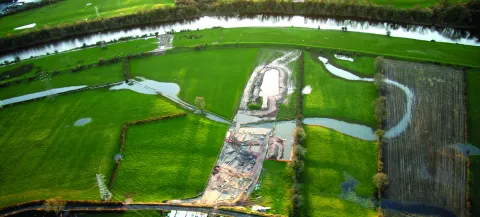
Between 2008 and 2009, Oxford Archaeology undertook an extensive programme of investigations in advance of the construction of the Carlisle Northern Development Route, Cumbria. In the course of this work, the team identified and excavated internationally significant prehistoric remains at Stainton West, near Carlisle, revealing huts, hearths, and a lithic assemblage of over 300,000 fragments. The outstanding finds, including two wooden tridents and 600 ochre fragments, came from a complex sequences of deposits within a paleochannel of the river Eden, which made possible the preservation of organic materials like wood. Some of the finds are permanently displayed at Tullie House Museum and Art Gallery in Carlisle and featured in the British Museum's The world of Stonehenge exhibition.
Radiocarbon dating has shown that the main phases of activity spanned c 6100-1400 cal BC, throughout the Mesolithic and Neolithic periods and into the Bronze Age.
As the publication of the monograph about Stainton West nears, the story told by its finds and data attracted the attention of David Keys, The Independent's archaeology correspondent. In his article "Archaeologists reveal evidence of British festival held 6,500 years ago", Mr Keys linked the 600 fragments of ochre and the evidence that the site was, at times, used for possibly votive depositions of objects to a use of the site for gatherings that would have brought together the smaller groups of people inhabiting the Cumbrian landscape during the Mesolithic and Neolithic periods.
This article sparked a lot of interest both in the UK and abroad, resulting in regional newspapers and international outlets reporting about the site and interviewing Fraser Brown, Regional Manager of the Lancaster office who led the works at Stainton West.
You can read Fraser's interview with the Miami Herald here.
